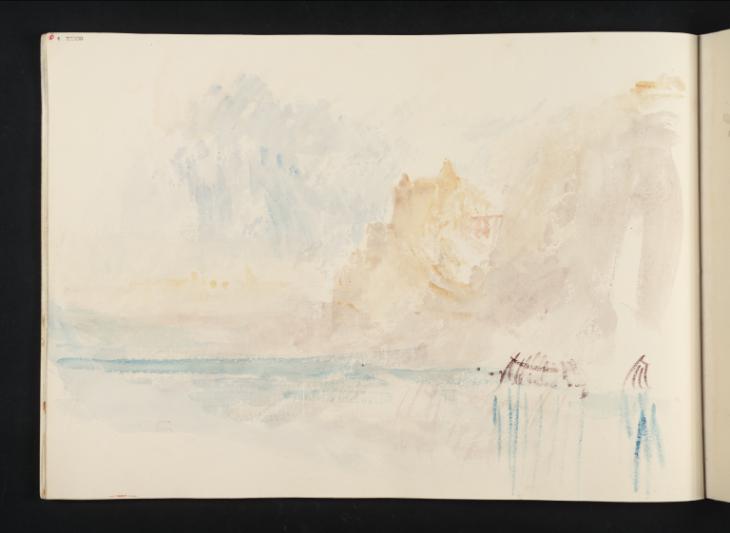Joseph Mallord William Turner Dieppe Castle from the East 1845
Joseph Mallord William Turner,
Dieppe Castle from the East
1845
Joseph Mallord William Turner 1775–1851
Folio 8 Recto:
Dieppe Castle from the East 1845
D35467
Turner Bequest CCCLX 9
Turner Bequest CCCLX 9
Gouache and watercolour on white wove paper, 232 x 332 mm
Watermarked ‘J WHATMAN TURKEY MILL 1844’
Inscribed by John Ruskin in red ink ‘9’ top left, upside down
Blind stamped with Turner Bequest monogram towards bottom left
Stamped in black ‘CCCLX 9’ top left, upside down
Watermarked ‘J WHATMAN TURKEY MILL 1844’
Inscribed by John Ruskin in red ink ‘9’ top left, upside down
Blind stamped with Turner Bequest monogram towards bottom left
Stamped in black ‘CCCLX 9’ top left, upside down
Accepted by the nation as part of the Turner Bequest 1856
References
1909
A.J. Finberg, A Complete Inventory of the Drawings of the Turner Bequest, London 1909, vol.II, p.1170, CCCLX 9, as ‘The Castle of Dieppe’.
Technique and condition
This study on smooth white wove paper has necessarily been worked on dry paper, since the sheet is bound into a sketchbook. All the light and rapidly applied washes have a definite, slightly hard edge as a result.
The paint medium in this work was investigated. Several gums were available in Turner’s era: notably gum arabic and gum tragacanth. The former is today used alone in commercial watercolour paints. The latter could be a practical choice because it does not ‘wash up’. This nineteenth-century term means that a later wash in gum tragacanth, applied to dried paper, would not wet and re-activate an earlier wash as much as would happen when gum arabic alone were used. That makes it very useful for an artist who applies multiple washes, uses plain water for washing out, and generally works his paper extensively, all of which describe Turner’s working methods. A method of chemical analysis called gas chromatography was used, which separates out components of a complex mixture to allow later identification. This was combined with mass spectrometry for more precise identification of the separated components. The result was that the gum used here was a mixture: gum arabic as the largest component, with gum tragacanth, and quite significant amounts of sugar or honey added. Added sugar or honey give flexibility to the paint film, useful if the artist chooses to apply it thickly as Turner did often, though not in this case. This gum mixture was found in commercial watercolour blocks which Turner stuck down onto card (in fact it was the invitation to a Royal Academy dinner to mark the annual exhibition) and a piece of leather, to form a travelling watercolour palette, now in the Royal Academy of Arts, London. These blocks were of the earlier ‘hard’ type that did not include sugar, but this paint may have come from a ‘soft’ block, which did.
The blue used in the foreground is Prussian blue, while the redder pigment in the sky may be ultramarine. The other colours are so thinly applied that they cannot be identified with much certainty, though a red lake and yellow ochre are likely.
Joyce Townsend
March 2011
How to cite
Joyce Townsend, 'Technique and Condition', March 2011, in John Chu, ‘Dieppe Castle from the East 1845 by Joseph Mallord William Turner’, catalogue entry, February 2014, in David Blayney Brown (ed.), J.M.W. Turner: Sketchbooks, Drawings and Watercolours, Tate Research Publication, April 2015, https://wwwAchieved without an underlying pencil drawing, this sketch depicts the western side of the castle at Dieppe as seen from the base of the chalk cliffs to the west of the town. The bulk of the medieval structure, with its high walls and battlements, shades into darker shades of ochre at the top of its towers.1 The tall arches of its large masonry bridge are picked out in dark pink. To impressive effect, the castle is brought closer to the sea then reality and the undulations of the cliffs exaggerated and reinforced by sweeping motions of the brush. The rows of curved brown objects to the right-hand side of the page may represent the decaying hulk of a shipwreck; their reflection in the seawater has been recreated with long thin strokes dragging blue gouache or very dry watercolour across page.
For reasons set out in the Technical notes in the sketchbook Introduction, this work appears inverted in relation to the volume as foliated.
Verso:
Blank; except for slight patches of grey watercolour near the binding transferred from folio 9 recto opposite (D35468; Turner Bequest CCCLX 10).
John Chu
February 2014
How to cite
John Chu, ‘Dieppe Castle from the East 1845 by Joseph Mallord William Turner’, catalogue entry, February 2014, in David Blayney Brown (ed.), J.M.W. Turner: Sketchbooks, Drawings and Watercolours, Tate Research Publication, April 2015, https://www

